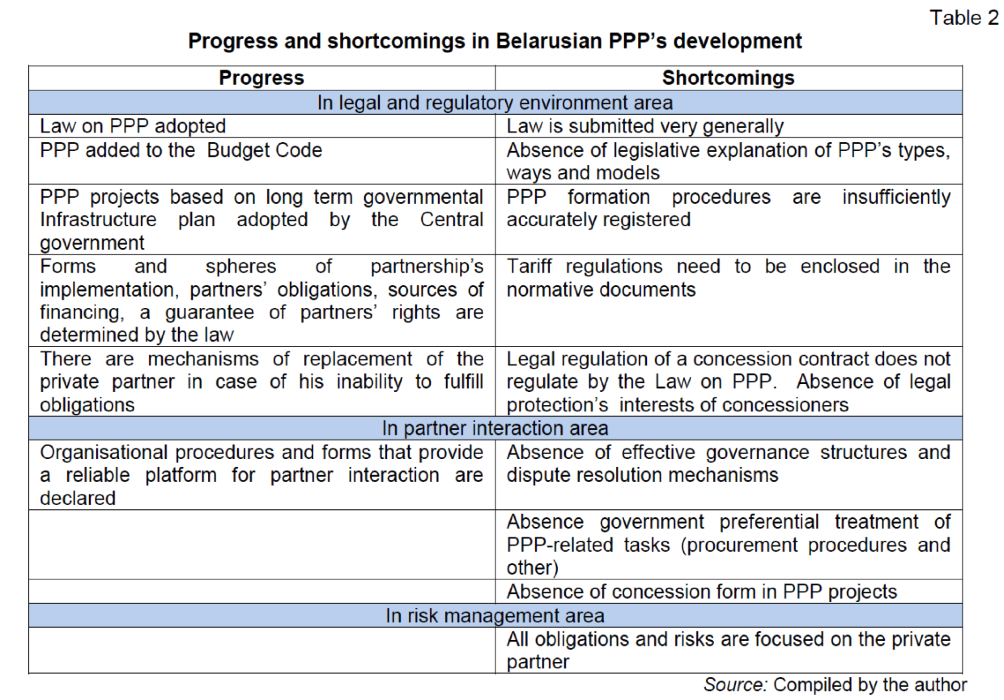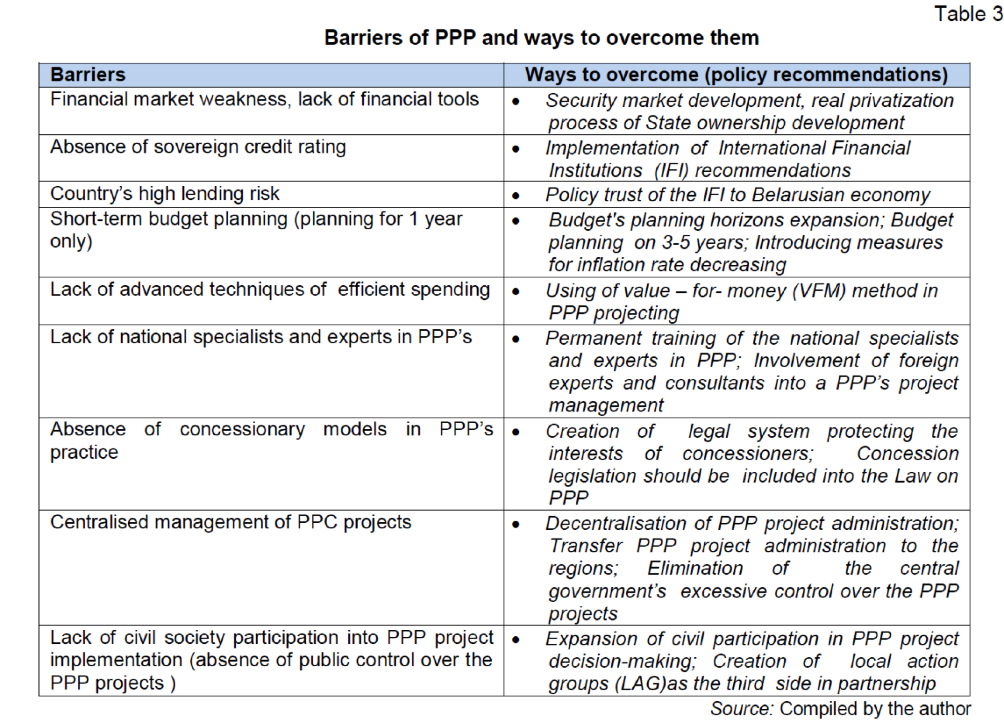 One of our previous blog posts already discussed the development of public-private partnership in the last two decades, as well as its benefits and potential negative effects in detail. Yuri Krivorotko‘s note will examine why PPPs need in Belarus and what are the main results and shortcomings in establishing the necessary regulatory and financial framework. The author argues that, for Belarusian economy and finance, PPP becomes even more demanded and urgent. Read more…
One of our previous blog posts already discussed the development of public-private partnership in the last two decades, as well as its benefits and potential negative effects in detail. Yuri Krivorotko‘s note will examine why PPPs need in Belarus and what are the main results and shortcomings in establishing the necessary regulatory and financial framework. The author argues that, for Belarusian economy and finance, PPP becomes even more demanded and urgent. Read more…
Nowadays a PPP concept is quite widespread in a circle of statesmen, legislators, representatives of business and experts in Belarus. What is it: fashionable name, craze or real need for a present economic life? The latest events in Belarusian economy and finance vividly show that the PPP role becomes even more demanded and urgent. It interests scientists, practitioners, experts to explore PPP’s experience both in EU and Post-Soviet countries and to use all its positive in infrastructures’ development and public services providing.
Why PPPs need in Belarus?
In condition of recession Belarus is faced with challenges one of which is need of capital investments in modern infrastructure under the very limited opportunities of the budgetary funding. Moreover, the tendency to decrease of budget funding is traced in recent years. According to the governmental infrastructure plan the share of infrastructure investment to GDP is reducing every year. If in 2006 this indicator was 1.2 percent, then in 2014 – 0.8 percent. It indicates the need to search new funding mechanisms for infrastructure projects. It mechanism should improve the living standards of population and maintenance of social standards level in comparison of last years. In the long term till 2020 the funding needs for creation of infrastructure facilities are estimated at $17.9 bn., and from 2021 to 2030 – $50.5 bn.

As the figure shows, an annual average gap between infrastructure investment needs and budgets’ capacity to fund it during 2016-2020 will be planned $1.57 bn., and during 2021-2030 -$ 2.41 bn. It is expected that the gap of funding should be covered by means of PPP projects. Thus nothing remains how to go on the way of financing by means of PPP’s.
PPP pilot projects in Belarus
Currently only seven from 63 submitted PPP projects will be implemented: two for road infrastructure, two for thermal and electric energy and three for welfare sphere (see Table 1).

The table above characterizes the pilot projects only which capture 27 percent of the national infrastructure plan of Republic of Belarus for 2016–2030. These figures give an essential optimism in infrastructure development by means of PPPs. It should be noted, however, the PPP pilot projects started in 2014-2016, therefore it is too early to provide any comment on them but some preliminary analysis of success factors and components may be done. However, there are risks of PPP projects to be failed due to deterioration of investment climate in Belarus where foreign investments for 9 months of 2016 are decreased on 2.4 bn. USD in comparison with the same period of 2015.
Progress and shortcomings in PPPs
Some progress in developing the legal and regulatory framework of PPP is evident – The Law on public – private partnership which has been adopted by the Belarusian Parliament in the end of 2015. The Law on PPP includes forms and spheres of implementation of partnership, obligation of partners, sources of financing, a guarantee of the rights of partners, mechanism of replacement of the private partner in case of his inability to fulfill the obligations, without terminating agreements, settlement of disputes, etc.
Some changes on regulatory environment of PPP have been brought by the recent additions to the Budget Code of the Republic of Belarus. Now from local budgets of different levels: oblasts, rayons, urban and rural budgets an infrastructure projects and programs concerning PPP can be funded. It gives a good ground for adoption of independent decisions for PPP’s projects implementation at all local levels.
However, some shortcomings about Law should be highlighted. Firstly, the Law is submitted very generally and has enough problematic issues and bottlenecks. There is no legislative explanation of PPP’s types, ways and models. Secondly, PPP formation procedures are insufficiently accurately registered, tariff regulations need to be enclosed in the normative documents. Thirdly, the legal regulation of a concession contract has not been changed and it is regulated now by the Investment Code through a specific concession agreement and not the Law on PPP. This issue is particularly important for private partners and needs to be complexly regulated by Law on PPP. It would be guarantee good relationships between government and private partner in terms of expenses and outcomes, for example, in sales, costs and profit sharing, taxes, other payments. In – fourth, no progress in risk management has been noticed so far, hence it is difficult to speak about improvement of relationship between the partners. The rearrangement of the obligations and risks between the parties should not focus on the private partner, only. Government should not limit itself to transfer land for construction or to supply of municipal waste, it should be involved in all cycle of production as an equal partner. Table 2 summarizes all progress and shortcomings in PPP’s development.

Obstacles are to be overcome
In addition to the shortcomings it should be focused on obstacles to PPP’s formation and management. They are:
- Weakness of financial market in Belarus. Most of PPP projects faced funding difficulties by private investors, government, international financial institutions. PPP partners must be provided with financial instruments.
- Belarus has not attained sovereign credit rating assigned by international rating agencies. That is a prerequisite seeking to obtain long-term debt financing instruments in international bond market. Funding by international financial institutions is a good instrument seeking to promote PPP.
- Risk insurance is problematic. Lending risk assessment in Belarus, carried out by some authoritative insurance agencies, show that the country belongs to group seven, i.e. high lending risk countries.
- Long-term budget planning is an important in long-term contracts therefore it is necessary to reconsider an approach to budget planning and allow drawing up plans for 3-5 years. The barrier for long term planning is a high inflation rate. For example, an inflation rate in Belarus for a last decade 19.58 percent makes long-term planning very complicated.
- Absence of efficient spending techniques. Efficient spending (value for money) depends on several factors, such as the chosen funding model, the selected private partner, etc.
- Deficit of competent local specialists and experts in PPP in Belarus who able to control fulfillment of contractual obligations of the private partner regarding works, costs, quality, services, efficiency, etc. Such experts should be recruited by each ministry engaged with PPC projects.
- Absence of concessional ways of PPP formation. In result, there are no concession contracts in PPP practice. It is a serious obstacle in real partnership and PPP development as a whole. The main reason why there are no concession contracts in Belarus is that the governmental part does not wish to bear equal responsibility in fulfillment of its obligations by the concessional agreement. Another reason is unwilling to lose control over state ownership assets. In addition, there are no regulations protecting the interests of the both parties. So, Belarusian government badly needs in scientifically grounded strategy for concession development.
- PPP project formation and its administration should be decentralised and not bureaucratic. Nodaway PPP projects in Belarus are developed by the central government and controlled by the ministries. It is no secret that power and administration in Belarus are centralized and projects are considered and approved by the central government. The public as well as local authorities have no voice in PPP projects’ decision-making although projects are implementing in their territories. Absence of the third party of PPP – civil society represented by public organizations. At decision making of PPP project implementation, the authority do not consult public, associations, non-governmental organisations. Another word, those people to whom public services intend and who have to be active actors in sustainable development situation. Civil participation in PPP has to be implemented through creation of local action groups (LAG). They have to connect the public and partners, observe balance of interest and represent the interests of all available local groups operating in the most various welfare branches. At decision making the share of private partners and associations has to make less than 50 percent of local representatives. Table 3 characterizes main barriers and ways to overcome them.

References:
Bovaird, T. Public–private partnerships: From contested concepts to prevalent practice. International Review of Administrative Sciences, 2004, Vol. 70, No. 2, pp. 199-216.
European Commission. (2003). Guidelines for successful public–private partnerships. Retrieved 14 November 2012 from http://ec.europa.eu/regional_policy/sources/docgener/guides/ppp_en.pdf..
Grimsey, D., Lewis, M. Public Private Partnerships: The Worldwide Revolution in Infrastructure Provision and Project Finance, Edward Elgar, Cheltenham, 2004.
Proekty gosudarstvenno-chastnogo partnerstva v regionah (2015) [PPP projects in regions], Dannye Kazahstanskogo tsentra gosudarstvenno-chastnogo partnerstva. Analitika. Retrieved 9 February 2015 from http://www.kzppp.kz/ru/project/table
Valuzhitskij, V.I. (2015). Razvitie gosudarstvenno – chastnogo partnerstva v Respublike Belarus: ot teorii k practice[Public – private partnership’s development in the Republic of Belarus: from theory to practice]. Sbornik nauchnyh statej XI mezhdunarodnoj nauchno – practicheskoj konferentsii“ Gosudarstvennoe regulirovanie ekonomiki i povyshenie effektivnosti deaytelnosti sub’ektov hozayistvovaniay. 16-17 aprelia 2015. Minsk, Akademia upravleniay pri Prezidente Respubliki Belarus.
